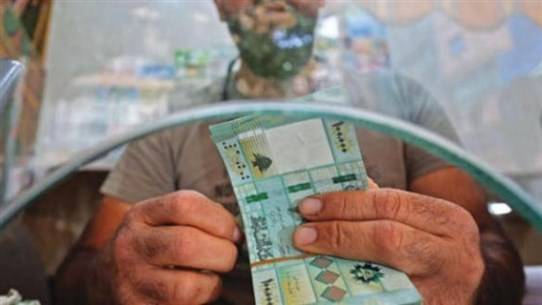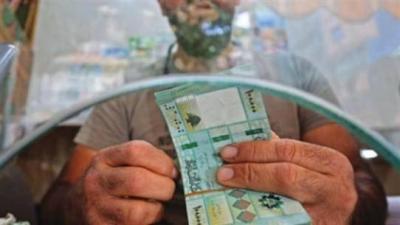The exchange rate of the Lebanese lira in the parallel exchange markets dropped again on Tuesday, bringing the dollar close to the threshold of 40,000 lira. This decline comes amidst conflicting information regarding delays in new regulatory measures that the central bank is preparing to implement, which stipulate an increase in the fees for withdrawals in hard currencies, along with the start of collecting customs duties on imports at a level of 15,000 lira to the dollar.
Sources following the situation have noted a renewed wave of demand for the green currency, escalating notably among exchange companies, which is reflected in the lira's continued drop towards record low levels, contradicting the atmosphere leaked by the central bank following its unexpected statement at the beginning of this month. This statement included a decision to stop purchasing dollars from the market while continuing to supply them through the "Sayrafa" platform.
This official disclosure, which involved the central bank's "refusal" to inflate demand for dollars, has led to widespread expectations of an imminent intervention by the central bank to inject more liquidity in dollars, similar to previous moves, as stated by banking sources. This effectively flipped the temporary equation, resulting in a significant increase in demand for the national currency, which saw substantial improvement within hours, reaching around 36,000 lira to the dollar, down from the 41,000 lira level it approached before the statement was issued.
A banking official explained to "Asharq Al-Awsat" that the "ambiguity" arising from the overlap of monetary decisions with financial necessities "still prevents determining the anticipated timing for the issuance of new measures." After initial expectations indicated that these measures would be officially adopted at the beginning of this month, following the announcement by the central bank to stop purchasing "fresh" dollars from parallel markets—resulting in an exceptional inflation in the monetary mass to almost 75 trillion lira—there were reports that government entities advised to wait, aiming for a synchronized implementation of financial steps related to the public budget with monetary measures concerning withdrawals. This supports expectations for the issuance of the promised circulars before the middle of the current month.
The banker confirms that leaks from concerned sources within the central bank "align with expectations for adopting a higher exchange rate for withdrawals from dollar accounts in banks as a first step in the task of reorganizing exchange rates in preparation for their unification, which responds to a basic demand of the package of conditions submitted by the International Monetary Fund in its preliminary agreement with the Lebanese side."
He adds: "Calmness in the monetary market is achieved by concentrating most transactions through the Sayrafa platform, which meets a significant part of the monthly quotas amounting to $400 in cash for individuals at a rate of about 30,000 lira per dollar currently." He points out that the promised monetary movements "coincide directly with financial developments, especially the anticipation of the enactment of related materials and effects in the public budget law, primarily granting all employees and workers in public sector institutions, as well as retirees, the equivalent of two extra monthly salaries, and starting the application of the customs dollar," in addition to "successive decisions to double public service fees, which began with subscriptions and mobile phone charges and recently extended to electricity supply fees, which the Ministry of Energy seeks to provide for 10 hours daily starting next month, after the central bank pledged to secure funding in dollars, according to the rate adopted on the platform."
The expectations were further strengthened by a notable development in the Bank of Lebanon's budget, represented by the third half-monthly increase in hard currency reserves, totaling about $637 million, raising reserves to around $10.3 billion by the end of October. This prompted business owners to reconstitute their positions in lira in pursuit of additional profits related to expectations of further improvements in the exchange rate.
According to an observation by "Asharq Al-Awsat," an exceptional and temporary openness has been noted in trade and consumer markets accepting payments in lira through bank cards, at 100% of the invoice amount, contrary to previous restrictive measures that required immediate cash payments exclusively or partial acceptance of payments by card at a maximum rate of 50 percent, in addition to many traders imposing fees for electronic payments.
Simultaneously, optimistic expectations have caused a clear contraction in the movement of withdrawals from dollar accounts through the existing exchange mechanism at a rate of 8,000 lira per dollar within limits of about 3,000 dollars monthly, after most bank administrations and branches leaked to depositors the central bank's intentions to raise the exchange price to 12 or 15 thousand lira, representing attractive differentials for depositors who often resort to investing their share of available withdrawals by purchasing cash dollars through the platform at a price close to 30,000 lira per dollar.
Thus, under the prevailing price, dollar account holders must exchange about 1,500 dollars to obtain 400 dollars in cash, the specified value for each individual monthly according to the price set on the platform managed by the central bank. This indicates accepting a deduction rate close to 73 percent to benefit from the differential in parallel markets, while depositors seek to reduce this deduction rate to about 50 percent if a rate of 15,000 lira is adopted instead of 8,000 lira for the exchange.




